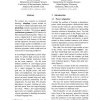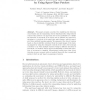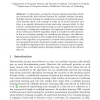310 search results - page 20 / 62 » MuFeSaC: Learning When to Use Which Feature Detector |
EMNLP
2009
13 years 7 months ago
2009
We connect two scenarios in structured learning: adapting a parser trained on one corpus to another annotation style, and projecting syntactic annotations from one language to ano...
ACCV
2007
Springer
14 years 3 months ago
2007
Springer
This paper presents a method for classifying the direction of movement and for segmenting objects simultaneously using features of space-time patches. Our approach uses vector quan...
HAIS
2010
Springer
13 years 7 months ago
2010
Springer
In this article, we describe a feature selection algorithm which can automatically find relevant features for multiple instance learning. Multiple instance learning is considered a...
PKDD
2009
Springer
14 years 3 months ago
2009
Springer
Abstract. We address the problem of joint feature selection in multiple related classification or regression tasks. When doing feature selection with multiple tasks, usually one c...
CIVR
2007
Springer
14 years 3 months ago
2007
Springer
Among the various types of semantic concepts modeled, events pose the greatest challenge in terms of computational power needed to represent the event and accuracy that can be ach...



